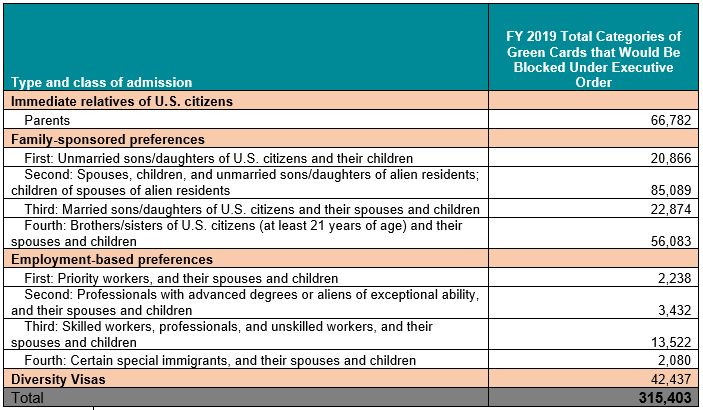What the COVID-19 immigration order means for new arrivals
On April 22, 2020, President Trump signed a “Proclamation Suspending Entry of Immigrants Who Present Risk to the U.S. Labor Market During the Economic Recovery Following the COVID-19 Outbreak.” The order went into effect at 11:59 p.m. on April 23 and was initially valid for 60 days, but on June 22 it was extended until December 31. It only applies to new arrivals from outside the U.S., not to people within the U.S. who adjust their status. Its main provisions are:
Suspends issuance of green cards to people currently outside the U.S., including:
- Employment-based green cards except for those entering as investors (EB-5)
- Green cards for spouses and children of green card holders
- Green cards for parents, siblings, and adult children of U.S. citizens
- Diversity program green cards (visa lottery)
Exempts the following individuals, who can still enter the U.S.:
- Current lawful permanent residents (green card holders)
- Individuals and their spouses and children entering on green cards as medical professionals to do essential work in the COVID-19 crisis
- Spouses and children under 21 of U.S. citizens
- Individuals with an investor visa (EB-5)
- Members of the US Armed Forces and their spouses and children
- Individuals who are needed for a law enforcement objective or whose entry would be in the national interest, and Afghans and Iraqis awarded Special Immigrant Visas after being employed by the U.S. government.
Those who try to evade the ban through fraud or illegal entry will be prioritized for deportation.
Asylum-seekers are not included in the ban. Non-immigrant visas – such as temporary workers, students, and exchange visitors – are also not impacted. However, the Proclamation requires that a recommendation be made on non-immigrant visas and any “other measures appropriate to stimulate the United States economy” within 30 days.
Despite its broad language, the short-term impact of the Proclamation is limited:
- Consulates suspended most visa appointments starting March 20, 2020, so few immigrant and non-immigrant visas are currently being issued.
- The vast majority of employment-based green cards are issued to workers already in the U.S., so only a relatively small number of employment-based green cards will be affected.
Overall, the Migration Policy Institute estimates that roughly 26,000 new arrivals per month could be blocked (not accounting for consular service suspensions), based on an estimated 315,000 annual arrivals in the covered categories:

Nevertheless, the ban will cause pain and anxiety to hundreds of thousands of families with active visa applications and, if allowed to continue once consulates reopen, it will decimate family-based immigration. Based on the MPI analysis, 4 in 5 of the affected visas involve family sponsorships.
Also of concern is the upcoming review of non-immigrant visas, which could lead to cuts in categories of particular importance to Massachusetts’ economy, such as H-1B, H-2A (agriculture), and H-2B (seasonal) visas – and those who come for education, training and cultural exchanges.
The President’s stated purpose is to protect the U.S. economy, but the facts suggest that he is instead using COVID-19 as a pretext to implement immigration restrictions that he has sought for years. Indeed, the order closely mirrors the RAISE Act, endorsed by Trump, which would have halved family-based immigration and created a point-based system for employment-based immigration.
At a time when we all need to come together to ensure a successful recovery, this Proclamation stokes division by falsely suggesting that Americans’ interests are in conflict with those of immigrants, and it lays the groundwork for deeply harmful and discriminatory long-term policies.
This analysis was written by Jessica Chicco, MIRA Staff Attorney, and Marion Davis, MIRA Communications Director, on April 23, 2020.
